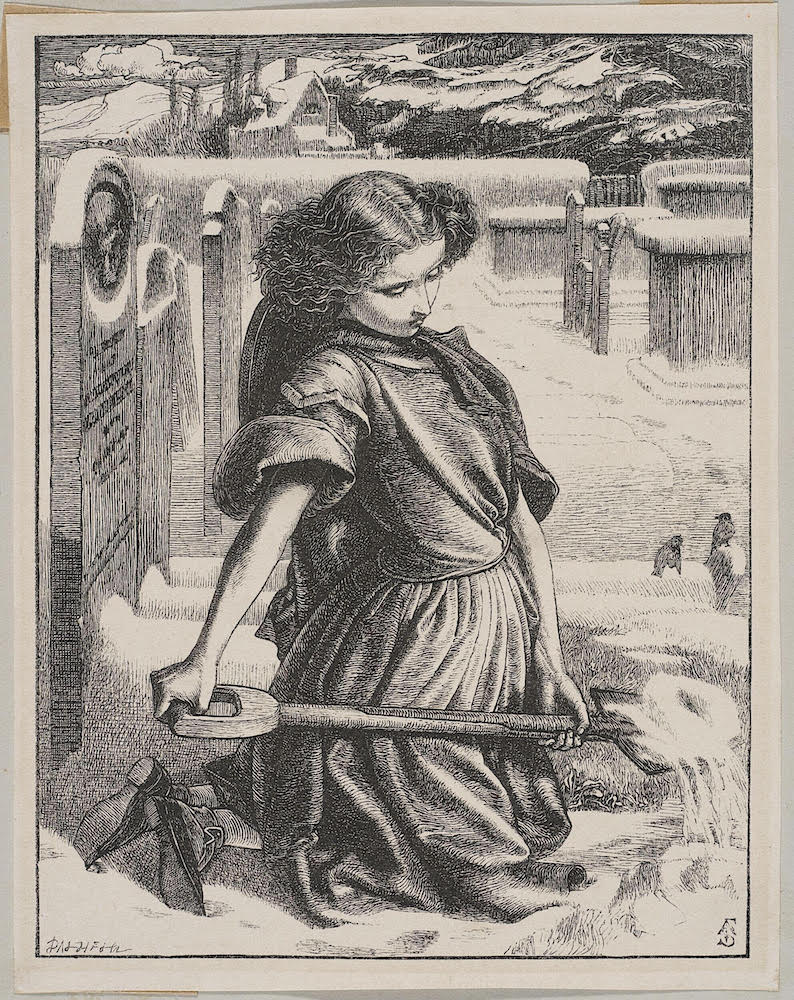

The Little Mourner. Left: 1861. Brush and black ink on cream paper; 5 ½ x 4 1/4 inches (13.8 x 10.8 cm). Collection of Birmingham Museum and Art Gallery, accession no.1906P834. Image courtesy of Birmingham Museums Trust made available under a Creative Commons Zero licence. Right: 1862. Wood engraving by Dalziel Brothers in black ink on cream paper. 5 1/2 x 4 1/4 inches (13.9 x 10.7 cm). Collection of Victoria and Albert Museum, London, accession no. E.1376-1910. Image courtesy of the museum. [Click on the images to enlarge them.]
Betty Elzea describes this drawing as follows: "The scene is a graveyard covered with snow. In the centre foreground is a young girl on her knees shovelling snow from two graves behind her. Beyond the boundary hedge of the graveyard is a snow-laden cedar tree to the left, and to the right, cottages, poplar trees, and distant hills" (207). The wood engraving is the same but with the image in reverse.
The drawing was commissioned to illustrate Dean Henry Alford's poem, "The Little Mourner," in English Sacred Poetry, compiled by the Rev. Robert Aris Willmott and first published by Routledge, Warne and Routledge, London, in 1862; it appears there on page 32. The poem tells of a young girl going to visit the graves of her parents and four sisters and explaining to a stranger why love compels her to clear their graves of snow. The wood engraving illustrates lines from the last stanza of the poem.
"Stranger, when the summer heats
Would dry their turfy bed,
Duly from this loving hand
With water it is fed;
They must be cleared this morning
From the thick-laid snow;
So now along the frosted field,
Stranger, let me go."
Elzea feels the design of this illustration may have been influenced by John Everett Millais's painting The Vale of Rest of 1858. She also feels that the head of the girl is strikingly like the "head of an angel in late 15th and early 16th century Northern European art, which he probably saw in woodcuts of the period" (208).
For his part, Forrest Reid saw this lovely drawing as marking Sandys out as one of the great draughtsman of the 1860s period: "The Little Mourner is again a drawing of a child. The poem is Dean Alford's, and describes how a girl kept watch, winter and summer, over the grave of her mother and sisters. The cemetery lies deep in snow, and beyond the walls we see the frozen hills and fields, the naked trees and houses. The drawing of the little girl is mastery, its exquisite purity of line - so sensitive and delicate in its strength - being hardly attained by any other draughtsman of the period" (60). Henry Reitlinger, however, considered the wood engraving to be preferable to the drawing: "The Little Mourner which appeared in Willmott'sSacred Poetry of the Nineteenth Century is more shaded and colourful in handling than is usual with him. The drawing for it, illustrated on plate XLV, may with advantage be compared with the wood-cut; unlike most drawings of the period, which lose all the finer points in the cutting, this one has lost nothing; if anything the wood-cut is the more effective of the two… a strangely pathetic conception ... generally and justly ranked among the loveliest things produced in the sixties" (94).
The original drawing was exhibited at the Arts and Crafts Exhibition Society held at the New Gallery in London in 1893, no. 341, and then later at the Winter Exhibition held at the Royal Academy in 1905, no. 968, that featured works by both Sandys and G.F. Watts. In both instances the drawing was lent by Charles Fairfax Murray.
Bibliography
Elzea, Betty. Frederick Sandys 1829-1904. A Catalogue Raisonné. Woodbridge, Suffolk: The Antique Collectors' Club Ltd., 2001, cat. 2.B.29, 207-08.
The Little Mourner. Birmingham Museums. Web. 21 August 2025.
The Little Mourner. Victoria and Albert Museum. Web. 21 August 2025.
Reid, Forrest. Illustrators of the Sixties. London: Faber & Gwyer Limited, 1928.
Reitlinger, Henry. From Hogarth to Keene. Black and White Drawings by the Story-tellers and Illustrators of the British School. London: Methuen & Co. Ltd., 1938.
Wilmott, Robert Aris, ed. The Poets of the Nineteenth Century. London: George Routledge, 1857 (the original illustration on this page, taken from this source, was added George P. Landow).
Created 1 November 2009
Last modified 21 August 2025